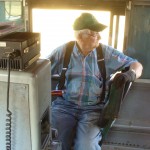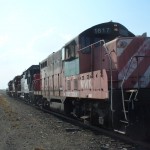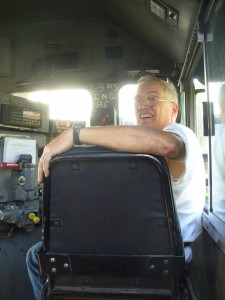From 1962 to 1966 I worked as a telegrapher on the Northern Pacific Railroad. It started a lifetime interest in railroads. I worked in depots up and down the Northern Pacific line from Thompson Falls Montana to Toppenish Washington. On Tuesday this week I got to play trains on one of the same branch lines that I worked as a telegrapher. This time I got to play with the real trains.
This is a somewhat convoluted story so I had best start at the beginning. In 1962 my roommate and good friend, Bruce Butler helped me get a summer job on the Northern Pacific as a relief telegrapher. As part of my job I worked in the stations at Cheney, Reardan, Wilber and Almira Washington. These were on a branch line called the Central Washington Branch, or CW Branch for short.
As many of you know I managed to get my Chemical Engineering degree and had a wonderful career in the paper industry. Over the years I still had railroading in my blood. I created a HO pike in the basement of the Warren Oregon home with my son, Glen. I often stop at railroad museums and have ridden on several excursion trains.

Recently I made connections with my college friend, and we discovered that we both still had railroading interests. What’s more, Bruce has managed to become a certified engineer on a small short line railroad here in Washington. Yes, incredibly, it is the same CW Branch that both of us worked as telegraphers in the ‘60s.
When we arrived in Spokane to visit my sisters I contacted Bruce and was invited along on a day long switching operation in Cheney Washington. Naturally I jumped at the chance. We arrived at the Cheney yard about 11:00 am and spent about half an hour checking and starting our engine, the NWIX 8925. (1) Once we got 8925 running and extracted from the house track we switched out our two bulk-head flats of steel destined for Geiger Industrial Park.
I was expecting a four person crew like the sixties; An engineer, fireman, brakeman and the boss of them all the conductor. Bruce was all of these. I was soon climbing down off the locomotive with the switch key to unlock and throw the switches, hooking up air lines and helping with the brake check before heading out of town. I wasn’t totally new to this. When I was a telegrapher in the sixties I often rode the engine in my off hours when the crews switched the station where I was working.
Soon we were heading for the CW Branch with our Warrant Orders in our pocket, so to speak. In the good old days I would have been the operator that copied the Train Orders and delivered them to the crew. Today our engineer copied his own orders over the cell phone. In those good old days we would have rolled along at 25 or 30 miles per hour on a well maintained right-of-way. Today we rocked and rolled along at 10 miles per hour. Along the way we spotted a flock of white pelicans at Four Lakes and a coyote near Medical Lake.
In due time we arrived at MP-8 and rendezvoused with Greg in the NWIX 1617. This GP7 was going strong when Bruce and I were working the CW Branch in the sixties.

We spent several hours switching stored empties around then delivering our two loads of steel and finally gathering our train to return to Cheney. For these moves Bruce and I moved over to the NWIX 1617 and Greg did most of the brakeman chores. Our consist for the return trip was an empty steel flat and two additional refurbished engines that were heading for leased duty at a destination somewhere off the BNSF.
We delivered our train to the interchange with the BNSF in Cheney and tied up both the NWIX 8925 and the NWIX 1617 on the House Track just after six. Oh yes, a couple of times Bruce let me sit in the engineers seat as an Engineer-In-Training. We certainly looked impressive with four locomotives pulling one empty flat car, even if three of the loco’s were dead.
If you doubt that I was having fun, just look at this snapshot that Bruce took of me in the engineer’s seat. Check out the speedometer, I was running within the speed limit of 10 miles per hour.

Citations:
- The NWIX 8925 is a General Electric EMD SD45 that produces 3600 horsepower from a 20 cylinder engine and was first placed in service in 1967.
- The NWIX 1617an EMD GP7 built in 1953 capable of delivering 1500 horse power from 16 cylinders.
It was just a typical day on the Geiger Spur. Normally Greg and I would have met at Cheney but this day Greg needed to bring the 1617 east from Davenport where it had had some mechanical work done on it last week.
When we are moving only 1 or 2 cars, it really isn’t all that difficult to do with only one person. Just have to stay alert and be safe.
We brought two ex DM&IR SD38AC units, numbers 201 & 205, into Cheney from Western Rail’s yard in Airway Heights. These locos were behind WRIX 6323, a nice clean GP35, so we had to pull it out of the Western Rail spur to get at the other two. Gary’s picture shows this. Then they were on the wrong side of the 1617, so we had to put them on the runaround track and get on the other side. Then backed up to get the empty steel car (bulkhead flat) which we left out of the way. The 8925 was at Geiger Jct, so when we got there with the 1617 we just coupled into the 8925 and shut down the 1617, using the 8925 for power into Cheney. To save fuel, we only run the locos that are actually needed.
NIWX 8925 was built by EMD, not GE as Gary had stated above. Here is the pedigree on both the 1617 and the 8925:
NIWX 8925: built by EMD 09/1971 as SCL 2025. Became SBD 8925, CSXT 8925, VMV 8925, MRL 8925. Assigned MRL number 383 but never renumbered. Painted SBD gray.
NIWX 1617: Built by EMD in December 1953 as CB&Q 261, a steam generator equipped passenger unit initially assigned to Chicago IL commuter service where it would have replaced steam power. One of the last GP7s built before the GP9 went into production in 1954. Still has its original 16-567-B diesel engine. Became BN 1617 after the 03/02/1970 merger of CB&Q into BN. Rebuilt by BN in the 1970s, but the original control stand was retained. Reconfigured for short hood forward operation and short hood chopped. Sold about 1982 to dealer Great Western Railway of Colorado. Transferred to N-C-O Division 1986 and then sold to Lake County (Oregon) Railroad 1996. Acquired by dealer Western Rail Inc in 2005 as trade-in on rebuilt GP9 1761. Leased to St. Maries River Railroad, Plummer, ID, in late 2006. Assigned to Western Rail Switching as power for the Geiger Spur on 11/8/2007. Acquired by NIWX when EWG took over operation of the Geiger Spur in January, 2009.
The other two units assigned to EWG that we did not use on 8/3/2010 are:
NIWX 8924: built by EMD 09/1971 as SCL 2024. Became SBD 8924, CSXT 8924, VMV 8924, MRL 8924. Assigned MRL number 382 but never renumbered. Painted SBD gray.
NIWX 375: built by EMD 01/1968. Ordered by the Pennsylvania, but delivered as Penn Central 6233. Served Conrail, then became CNW 6556, then NRE 6556, and finally MRL 375. Painted MRL blue.
All 3 SD45s have their original 20-645-E3 diesel engines and retain their original 3600 hp rating. They are good, powerful units.